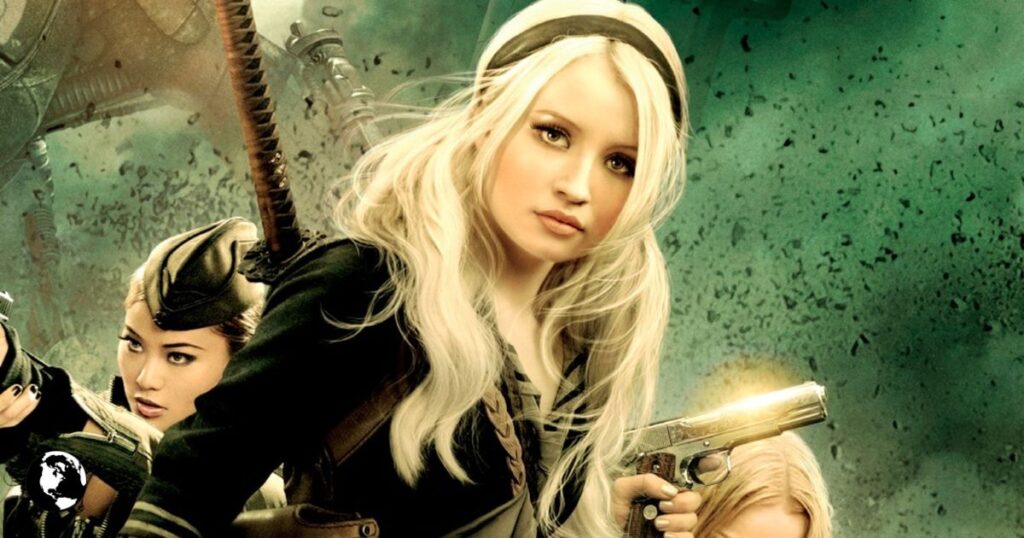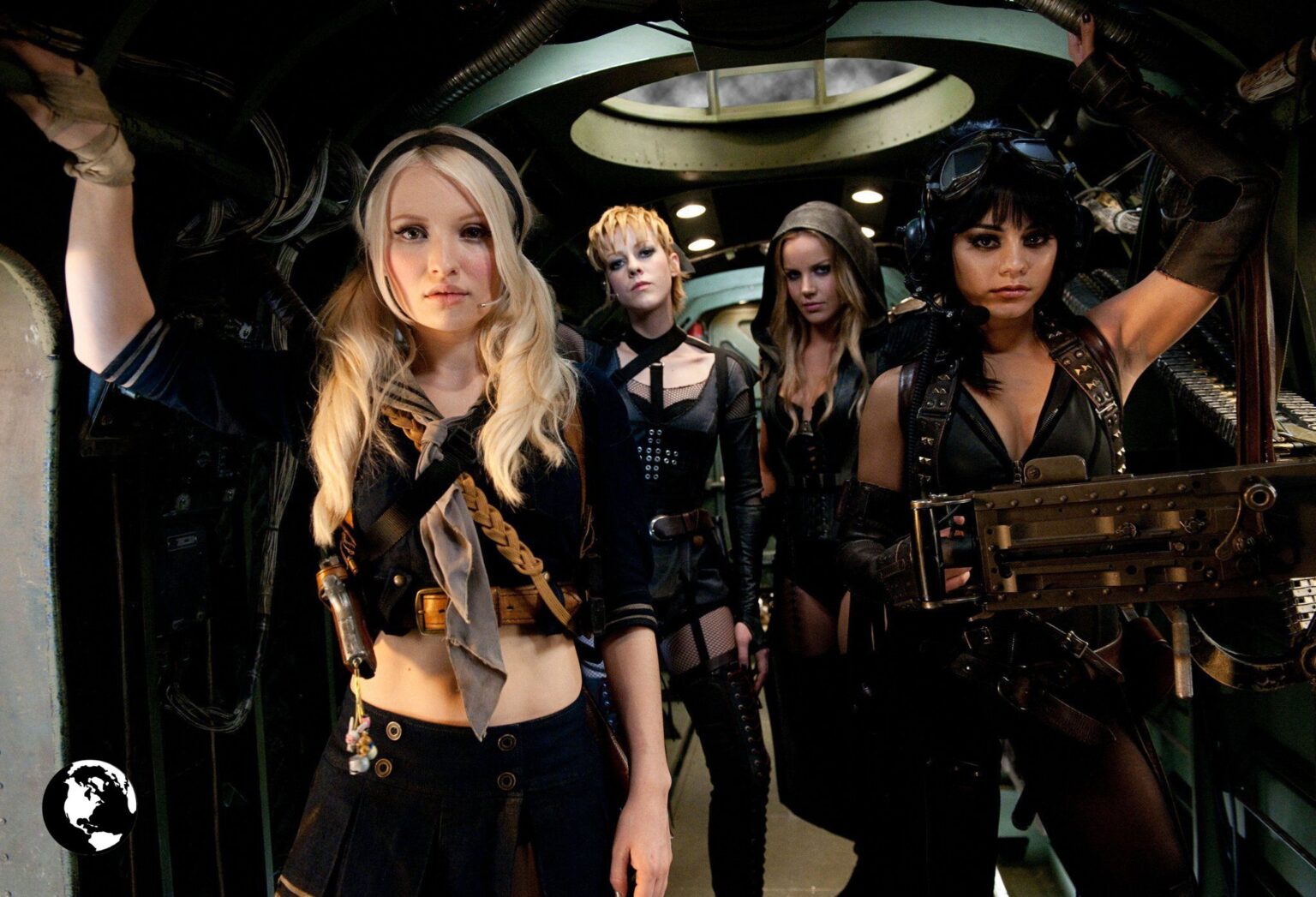Suckernpunch, released on March 25, 2011, is a fantasy action film directed by Zack Snyder, known for his bold visual storytelling. Born out of Snyder’s vision to merge surreal fantasy with emotional depth, the movie introduced audiences to Babydoll, a young woman navigating layered realities. Featuring stars like Emily Browning, Abbie Cornish, Vanessa Hudgens, and Jena Malone, it blends action, drama, and symbolism. With a production budget of over $75 million, Suckernpunch became one of Snyder’s most debated works. Its unique mix of style and story earned both cult admiration and sharp criticism. Today, Suckernpunch remains notable for its daring aesthetics and ongoing cultural debate.
The World of Suckernpunch
Suckernpunch follows Babydoll, a young woman institutionalized in a mental asylum after being betrayed by her stepfather. In an attempt to cope with her trauma, Babydoll imagines alternative realities where she and other inmates fight for freedom.
These worlds shift between gritty brothel settings and dreamlike battlefields filled with dragons, robots, and samurai warriors. Each layer of fantasy represents a desperate attempt to gain control in a world that has stripped her of agency.
The very word Suckernpunch reflects the film’s goal: to hit viewers unexpectedly, both emotionally and visually.
Visual Style and Cinematic Aesthetics
Zack Snyder’s style is unmistakable, and in Suckernpunch he pushed it to extremes. Every sequence bursts with stylized visuals:
- Samurai warriors towering over Babydoll
- Dystopian cityscapes filled with steam-powered soldiers
- A dragon battle that feels like myth meeting modern fantasy
These moments turn Suckernpunch into an art piece as much as a narrative. Critics often claimed the visuals overshadowed the story, but admirers argue that the style is the story. Each frame is a painting, designed to immerse viewers in Babydoll’s fractured imagination.
Storytelling Layers and Narrative Complexity

The structure of Suckernpunch is deliberately complex. At the surface is the asylum. Beneath it is a brothel, reimagined by Babydoll’s mind. Within that brothel setting are further fantasy realms where quests and battles unfold.
This multi-layered approach confuses some viewers but excites others who see it as experimental storytelling. The fragmented structure mirrors Babydoll’s fractured psyche. Suckernpunch asks the audience to piece together meaning instead of presenting a straightforward narrative.
Symbolism and Hidden Meanings
Beyond its visual spectacle, Suckernpunch is heavy with symbolism. The four items Babydoll seeks a map, fire, a knife, and a key represent survival, knowledge, and sacrifice.
The asylum symbolizes patriarchal control. The brothel transforms that control into a metaphor of exploitation. The fantasy worlds highlight internal resistance and resilience.
For some viewers, Suckernpunch becomes a story about how imagination can become both a prison and a weapon. Others feel the symbolism is muddled, buried under excessive spectacle.
Feminist Critiques and Gender Debates
Few films generate as much debate about gender as Suckernpunch. On one hand, the movie portrays its female leads in revealing costumes, fighting stylized battles designed for spectacle. Critics argue this reduces the characters to objects of visual pleasure.
On the other hand, defenders argue that Suckernpunch is not glorifying exploitation but exposing it. By exaggerating sexualization, Snyder may have been holding up a mirror to society’s treatment of women.
This duality makes Suckernpunch endlessly debatable. Is it feminist or anti-feminist? Exploitative or critical of exploitation? The lack of a definitive answer keeps the conversation alive.
Music and Mood as Storytelling Tools
The soundtrack of Suckernpunch deserves its own recognition. Instead of relying on original scores alone, Snyder reimagined existing songs to fit the mood of each scene. Emily Browning, who plays Babydoll, performed haunting versions of classics like “Sweet Dreams (Are Made of This).”
Music in Suckernpunch is not background noise it drives emotion, sets rhythm, and creates atmosphere. The action sequences are synchronized with sound, transforming fight scenes into cinematic dance.
The Role of Fantasy and Escapism
At its heart, Suckernpunch is about escapism. For Babydoll and her companions, fantasy becomes survival. The grim asylum transforms into dreamscapes where they wield weapons, confront monsters, and grasp at freedom.
This theme resonates with audiences beyond the screen. Many interpret Suckernpunch as a metaphor for how people cope with trauma. Escapism can be criticized as avoidance, but in this context, it becomes an act of resilience.
Cultural Impact and Reception
Upon release, Suckernpunch received harsh criticism. Rotten Tomatoes gave it low scores, and many reviewers dismissed it as style without substance. Metacritic echoed the sentiment, labeling it “generally unfavorable.”
Yet despite poor critical reception, Suckernpunch has earned cult status. Fans dissect its themes, defend its ambition, and argue it was ahead of its time. Online communities revisit it as a misunderstood experiment that challenged cinematic conventions.
Legacy and the Director’s Cut
Over the years, Zack Snyder has suggested that a director’s cut of Suckernpunch exists, one that aligns more closely with his vision. Fans hope this version could answer lingering questions and strengthen the narrative.
Whether or not the director’s cut is ever released, Suckernpunch has cemented its place in modern film discussions. It represents risk-taking in mainstream cinema—a film unafraid to polarize.
Conclusion
Suckernpunch is not an easy film to categorize. It is visually stunning, narratively experimental, and symbolically dense. Its portrayal of women invites both criticism and defense. Its music elevates its mood, while its fantasy layers highlight the human need for escape.
In the end, the battle between style, story, and symbolism is what defines Suckernpunch. It remains a film that challenges expectations, sparks debate, and refuses to fade into obscurity. Whether seen as flawed or visionary, it continues to deliver that sudden emotional impact true to its name.
FAQs
1. What is the meaning of Suckernpunch?
It means an unexpected or unfair blow. In the film, it symbolizes sudden emotional and psychological impact.
2. Is Suckernpunch a feminist film?
Interpretations differ. Some see it as exploitative, while others argue it critiques exploitation and oppression.
3. Why was Suckernpunch criticized?
It was criticized for emphasizing visuals over coherent storytelling and for its portrayal of women.
4. Is there a Suckernpunch director’s cut?
Zack Snyder has mentioned it, but it has not been officially released.
5. Why does Suckernpunch remain popular?
Its bold style, layered symbolism, and ongoing debates about meaning keep it relevant.

